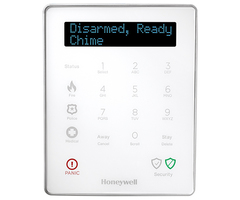What if Someone Destroys My Lyric Before it Calls My Security Company?
Honeywell's APL technology is designed to protect systems like the Lyric. Essentially, a ping is sent to the central station upon an entry zone fault when the system is armed. If a disarm or alarm signal is not reported before the end of the delay period, it triggers an APL alarm event.
Advanced Protection Logic (APL) was introduced by Honeywell as a way to protect their line of self-contained wireless alarm systems from destruction during the entry delay. Unlike older, traditional wired alarm systems, self-contained panels like the Lyric have all the communication modules and electronics built into the keypad itself. Although this offers convenience for obvious reasons, it does open up the concern of an intruder damaging the unit and compromising the communications. APL protects alarm owners from this type of situation.
Even if an intruder destroys the system after they enter the location, the signal sent from the APL ping will have the monitoring station react as if it was a normal alarm event. As long as they get the ping, a virtual timer is set, and if disarm or alarm signals are not received, it will trigger the APL alarm event.
When the system is armed to Stay or Away mode, only zones (doors in this case) that have the Entry/Exit attribute will be able to be opened without putting the system into a full alarm. When the system is armed and an entry door is opened, the system will go into a countdown known as the Entry Delay Timer. This is a period of time that lets a user get to the system and disarm without having the system go into a full alarm. With the APL feature, when the entry door is opened, the Lyric will send a signal to the central monitoring station. If the central monitoring station doesn’t receive a disarm signal by the end of the entry delay timer, they will initiate the dispatch procedure that they have established. Without this feature, an intruder could pry open the front door and destroy the system before it had the chance to go into a full alarm.
The APL feature requires a central monitoring station to be actively monitoring the system. APL won’t work for users that don’t have central station monitoring. This is also true for Total Connect 2.0 customers. This is due to the limitations of the technology, along with the need for a central station to be involved in receiving the ping from an entry/exit zone fault and monitoring the unit for a disarm and alarm signal.
To further protect your Lyric controller, we recommend placing it somewhere out of view or far from entry points. You can then use the Total Connect app, wireless key fobs or Z-wave locks to arm and disarm the system after you exit. If one of these methods fits your lifestyle, you can set all your zones to perimeter so that they do not have an entry delay that you will have to worry about. Otherwise, you can keep your entry doors on delay and use a LKP500 wireless keypad for control at the entry points. If this keypad is smashed by an intruder, it will not compromise your alarm reporting.
Did you find this answer useful?
We offer alarm monitoring as low as $10 / month
Click Here to Learn MoreRelated Products


Related Categories
- Answered
- Answered By
- Joe Gonnella
